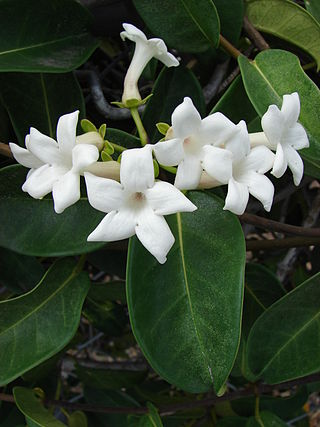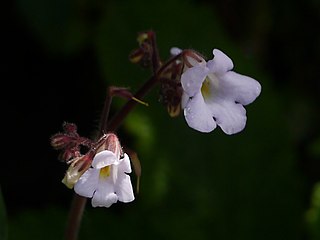| Pergularia | |
|---|---|
 | |
| Pergularia daemia in Hyderabad, India | |
| Scientific classification | |
| Kingdom: | Plantae |
| Clade: | Tracheophytes |
| Clade: | Angiosperms |
| Clade: | Eudicots |
| Clade: | Asterids |
| Order: | Gentianales |
| Family: | Apocynaceae |
| Subfamily: | Asclepiadoideae |
| Tribe: | Asclepiadeae |
| Genus: | Pergularia L. |
Pergularia is a genus of the botanical family Apocynaceae. Pergularia daemia is a perennial twinning herb that grows along the roadsides of India and tropical and subtropical regions in South Asia, Africa, and Australia. [1]
Pharmacological activities include antiinflammatory, hepatoprotective, anticancer, antidiabetic, antioxidant, antibacterial, antifungal, analgesic, anti-infertility and central nervous system depressant activity. [2]
- Species [3]
- Pergularia adenophylla Schltr. & K. Schum. - Cameroon
- Pergularia brunoniana (Wight & Arn.) D.Dietr. - India
- Pergularia calesiana (Wight) Buch.-Ham. ex Hook.f. - Himalayas
- Pergularia clausa (R.Br.) Spreng. - Jamaica
- Pergularia daemia (Forssk.) Chiov. - Africa, S Asia
- Pergularia exilis (Colebr.) Spreng. - Bangladesh
- Pergularia flavescens (A.Cunn.) Hook.f. ex D.Dietr.
- Pergularia hamiltonii (Wight) D.Dietr. - Uttar Pradesh
- Pergularia rostrata (R.Br.) Spreng. - Queensland
- Pergularia roylei (Wight) D.Dietr. - Himachal Pradesh
- Pergularia suaveolens (R.Br.) Spreng. - Australia
- Pergularia tinctoria (R.Br.) Spreng. - Sumatra
- Pergularia tomentosa L. - Middle East from Egypt to Pakistan
- Pergularia viridiflora (R.Br.) Spreng. - Australia
- formerly included [3]
Moved to other genera – Cionura , Marsdenia , Strophanthus , Telosma , Vincetoxicum (syn. Tylophora), Vallaris
- P. accedens, syn of Telosma accedens
- P. africana, syn of Telosma africana
- P. angustiloba, syn of Telosma angustiloba
- P. celebica, syn of Telosma celebica
- P. divaricata, syn of Strophanthus divaricatus
- P. erecta, syn of Cionura erecta
- P. filipes, syn of Telosma procumbens
- P. glabra, syn of Vallaris glabra
- P. minor, syn of Telosma cordata
- P. pallida, syn of Telosma pallida
- P. parviflora, syn of Marsdenia parviflora
- P. procumbens, syn of Telosma procumbens
- P. puberula, syn of Telosma puberula
- P. sanguinolenta, syn of Cryptolepis sanguinolenta
- P. sinensis, syn of Cryptolepis sinensis
- P. tenacissima, syn of Marsdenia tenacissima
- P. velutina, syn of Tylophora velutina






